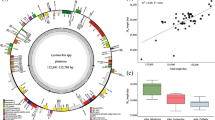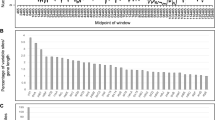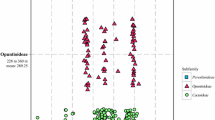Abstract
In this study we reconstruct the structural evolution of the hyper-variable P6b region of the group I trnLeu intron in a monophyletic group of lichen-symbiotic Nostoc strains and establish it as a useful marker in the phylogenetic analysis of these organisms. The studied cyanobacteria occur as photosynthetic and/or nitrogen-fixing symbionts in lichen species of the diverse Nephroma guild. Phylogenetic analyses and secondary structure reconstructions are used to improve the understanding of the replication mechanisms in the P6b stem–loop and to explain the observed distribution patterns of indels. The variants of the P6b region in the Nostoc clade studied consist of different combinations of five sequence modules. The distribution of indels together with the ancestral character reconstruction performed enables the interpretation of the evolution of each sequence module. Our results indicate that the indel events are usually associated with single nucleotide changes in the P6b region and have occurred several times independently. In spite of their homoplasy, they provide phylogenetic information for closely related taxa. Thus we recognize that features of the P6b region can be used as molecular markers for species identification and phylogenetic studies involving symbiotic Nostoc cyanobacteria.




Similar content being viewed by others
References
Bakker FT, Culham A, Gomez-Martinez R, Carvalho J, Compton J, Dawtrey R, Gibby M (2000) Patterns of nucleotide substitution in angiosperm cpDNA trnL (UAA)-trnF (GAA) regions. Mol Biol Evol 17:1146–1155
Besendahl A, Qiu Y-L, Lee J, Palmer JD, Bhattacharya D (2000) The cyanobacterial origin and vertical transmission of the plastid tRNALeu group-I-intron. Curr Genet 37:12–23
Borsch T, Hilu W, Quandt D, Wilde V, Neinhuis C, Barthlott W (2003) Non-coding plastid trnT–trnF sequences reveal a well resolved phylogeny of basal angiosperms. J Evol Biol 16:558–576
Costa J-L, Paulsrud P, Lindblad P (2002) The cyanobacterial tRNALeu (UAA) intron: evolutionary patterns in a genetic marker. Mol Biol Evol 19(6):850–857
Costa J-L, Paulsrud P, Rikkinen J, Lindblad P (2001) Genetic diversity of Nostoc endophytically associated with two bryophyte species. Appl Environ Microbiol 67:4393–4396
Dirks RM, Pierce NA (2003) A partition function algorithm for nucleic acid secondary structure including pseudoknots. J Comput Chem 24:1664–1677
Dirks RM, Pierce NA (2004) An algorithm for computing nucleic acid base-pairing probabilities including pseudoknots. J Comput Chem 25:1295–1304
Dirks RM, Bois JS, Schaeffer JM, Winfree E, Pierce NA (2007) Thermodynamic analysis of interacting nucleic acid strands. SIAM Rev 49:65–88
Elhai J, Kato M, Cousins S, Lindblad P, Costa JL (2008) Very small mobile repeated elements in cyanobacterial genomes. Genome Res 18:1484–1499
Elvebakk A, Papaefthimiou D, Robertsen EH, Liaimer A (2008) Phylogenetic patterns among Nostoc cyanobionts within bi- and tripartite lichens of the genus Pannaria. J Phycol 44:1049–1059
Fedrowitz K, Kaasalainen U, Rikkinen J (2011) Genotype variability of Nostoc symbionts associated with three epiphytic Nephroma species in a boreal forest landscape. The Bryologist 114(1):220–230
Han D, Fan Y, Hu Z (2009) An evaluation of four phylogenetic markers in Nostoc: implications for cyanobacterial phylogenetic studies at the intragenic level. Curr Microbiol 58:170–176
Huelsenbeck JP, Ronquist F (2001) MrBayes: bayesian inference of phylogenetic trees. Bioinformatics 17:754–755
Huelsenbeck JP, Ronquist F, Nielsen R, Bollback JP (2001) Bayesian inference of phylogeny and its impact on evolutionary biology. Science 294:2310–2314
Huelsenbeck JP, Larget B, Miller RE, Ronquist F (2002) Potential applications and pitfalls of bayesian inference of phylogeny. Syst Biol 51:673–688
Kelchner SA (2000) The evolution of non-coding chloroplast DNA and its application in plant systematics. Ann Mo Bot Gard 87:482–498
Kelchner SA, Clark LG (1997) Molecular evolution and phylogenetic utility of the chloroplast rpl16 intron in Chusquea and the Bambusoideae (Poaceae). Mol Phyl Evol 8:385–397
Kelchner SA, Wendel JF (1996) Hairpins create minute inversions in non-coding regions of chloroplast DNA. Curr Genet 30:259–262
Müller K (2007) PRAP2-Likelihood and parsimony ratchet analysis, v.0.9
Müller K, Quandt D, Müller J, Neinhuis C (2005) PhyDE® 0.995: Phylogenetic Data Editor, http://www.phyde.de
Müller KF, Borsch T, Khidir WH (2006) Phylogenetic utility of rapidly evolving DNA at high taxonomical levels: contrasting matK, trnF, and rbcL in basal angiosperms. Mol Phyl Evol 41:99–117
Nixon KC (1999) The parsimony ratchet, a new method for rapid parsimony analysis. Cladistics 15:407–414
O’Brien H, Miadlikowska J, Lutzoni F (2005) Assessing host specialization in symbiotic cyanobacteria associated with four closely related species of the lichen fungus Peltigera. Eur J Phycol 40:363–378
Oksanen I, Lohtander K, Sivonen K, Rikkinen J (2004) Repeat type distribution in trnL intron does not correspond with species phylogeny: comparison of the genetic markers 16S rRNA and trnL intron in heterocystous cyanobacteria. Int J Syst Evol Microbiol 54:765–772
Pagel M, Meade A (2004) A phylogenetic mixture model for detecting pattern-heterogeneity in gene sequence or character-state data. Syst Biol 53:571–581
Paquin B, Kathe SD, Nierzwicki-Bauer SA, Shub DA (1997) Origin and evolution of group-I introns in cyanobacterial tRNA genes. J Bacteriol 179:6798–6806
Paulsrud P, Lindblad P (1998) Sequence variation of the tRNALeu intron as a marker for genetic diversity and specificity of symbiotic cyanobacteria in some lichens. Appl Environ Microbiol 64:310–315
Paulsrud P, Rikkinen J, Lindblad P (1998) Cyanobiont specificity in some Nostoc-containing lichens and in a Peltigera aphthosa photosymbiodeme. New Phytol 139:517–524
Paulsrud P, Rikkinen J, Lindblad P (2000) Spatial patterns of photobiont diversity in some Nostoc-containing lichens. New Phytol 146:291–299
Paulsrud P, Rikkinen J, Lindblad P (2001) Field investigations on cyanobacterial specificity in Peltigera aphthosa. New Phytol 152:117–123
Pirie MD, Balcázar Vargas MP, Botermans M, Bakker F, Chatrou LW (2007) Ancient paralogy in the cpDNA trnL-F region in Annonaceae: implications for plant molecular systematic. Am J Bot 94:1003–1016
Quandt D, Stech M (2005) Molecular evolution of the trnL (UAA) intron in bryophytes. Mol Phylogenet Evol 36:429–443
Quandt D, Müller K, Stech M, Frahm JP, Frey W, Hilu KW, Borsch T (2004) Molecular evolution of the chloroplast trnL-F region in land plants. Monogr Syst Bot Mo Bot Gard 98:13–37
Rambaut A, Drummond AJ (2007) Tracer v1.4. Available from http://beast.bio.ed.ac.uk/Tracer
Rikkinen J, Oksanen I, Lohtander K (2002) Lichen guild share related cyanobacterial symbionts. Science 297(5580):357
Rudi K, Jakobsen KS (1999) Complex evolutionary patterns of tRNALeu (UAA) group-I introns in cyanobacterial radiation. J Bacteriol 181:3445–3451
Rudi K, Fossheim T, Jakobsen KS (2002) Nested evolution of a tRNALeu (UAA) group I intron by both horizontal intron transfer and recombination of the entire tRNA locus. J Bacteriol 184:666–671
Simon D, Fewer D, Friedl T, Bhattacharya D (2003) Phylogeny and self-splicing ability of the plastid tRNA-Leu group I intron. J Mol Evol 57:710–720
Sotiaux A, Enroth J, Olsson S, Quandt D, Vanderpoorten A (2009) When morphology and molecules tell us different stories: a case-in-point with Leptodon corsicus, a new and unique endemic moss species from Corsica. J Bryol 31:186–196
Stöver BC, Müller KF (2010) TreeGraph 2: combining and visualizing evidence from different phylogenetic analyses. BMC Bioinformatics 11:7
Swofford DL (2002) PAUP*. Phylogenetic Analysis Using Parsimony (*and Other Methods). Version 4. Sinauer Associates, Sunderland
Taberlet P, Coissac E, Pompanon F, Gielly L, Miquel C, Valentini A, Corthier G, Brochmann C, Willerslev E (2007) Power and limitations of the chloroplast trnL (UAA) intron for plant DNA barcoding. Nucleic Acids Res 35:e14
Wright D, Prickett T, Helm RF, Potts M (2001) Form species Nostoc commune (Cyanobacteria). Int J Syst Evol Microbiol 51:1839–1852
Zadeh N, Steenberg CD, Bois JS, Wolfe BR, Pierce MB, Khan AR, Dirks RM, Pierce NA (2011) NUPACK: analysis and design of nucleic acid systems. J Comput Chem 32:170–173
Zuker M (1989) On finding all suboptimal foldings of an RNA molecule. Science 244:48–52
Acknowledgments
S. Ares and J. Bois are acknowledged for helpful discussion. The project was funded by the Finnish Academy (grant to JR, project number 122288). We are grateful to the comments of the reviewers and the associated editor Stefan Hohmann.
Conflict of interest
The authors declare that they have no conflict of interest.
Author information
Authors and Affiliations
Corresponding author
Additional information
Communicated by S. Hohmann.
Rights and permissions
About this article
Cite this article
Olsson, S., Kaasalainen, U. & Rikkinen, J. Reconstruction of structural evolution in the trnL intron P6b loop of symbiotic Nostoc (Cyanobacteria). Curr Genet 58, 49–58 (2012). https://doi.org/10.1007/s00294-011-0364-0
Received:
Revised:
Accepted:
Published:
Issue Date:
DOI: https://doi.org/10.1007/s00294-011-0364-0




